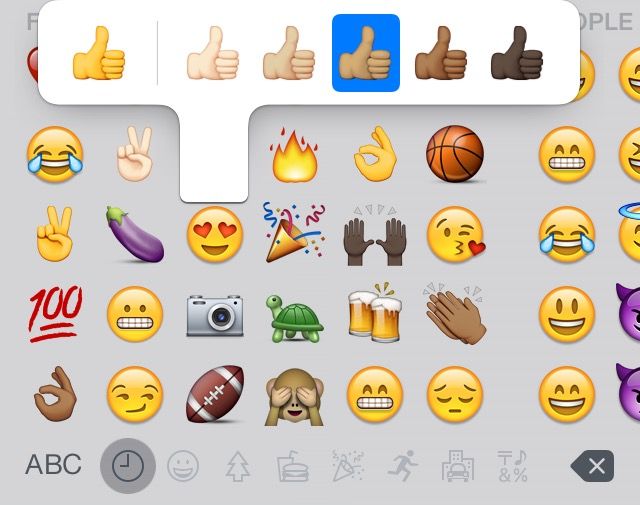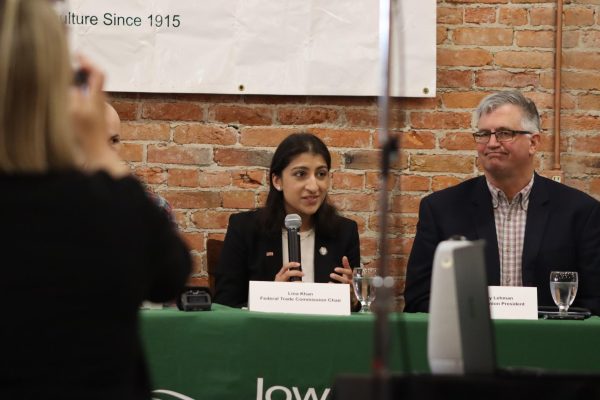Apple adds diversity to emojis, reflects changing society
In the iOS 8.3 update, Apple has added 300 more emojis. Included in the additions is the option to change the formerly standard “Caucasian” emoji to a different skin color.
April 28, 2015
iPhone users can now see 300 additional faces in their emoji lists, thanks to an updated keyboard on the iOS 8.3.
Emojis are small digital images that can be accessed through virtual keyboards used to express emotions on smartphones, tablets and PCs.
The option to be able to change the standard “Caucasian” emoji to a different skin tone color is exciting college students and teachers.
The current set of emojis may include an Asian man wearing a Gua Pi Mao cap and an Indian man wearing a turban, but there were no ethnically diverse people represented. This will change when iPhone owners update their devices with iOS 8.3 because several of the tiny cartoon emojis are now available in six new skin tones.
Apple has also added more relationship emojis. For example, same-sex relationship emojis with families with two mothers and two fathers have been added. Emojis for 32 more country flags have also been added in iOS 8.3. Apple iOS 8.3 was released in early April and is now available for iPhone and iPod users to download.
Tabatha Cruz, coordinator for retention with Multicultural Student Affairs, said she found out about the new diverse emojis through one of her coworkers and was excited about it. Cruz isn’t an iPhone user herself, as she has an Android, but she got the update on her iPod. After she saw the emojis on her iPod she started using them all and started sending the diverse emojis to her sister.
“I was really excited about it, especially cause I’m pretty social media savvy for the most part so I thought it was pretty exciting that ‘oh, I have an emoji that looks like me,’” Cruz said.
Cruz said she is overjoyed that Apple has added more flags to choose from. Before, the only ones available were the German flag and Chinese flag.
“Puerto Rico is on there. I’ll definitely be using mine a lot more,” Cruz said.
Kenyatta Shamburger, assistant dean of students and director of multicultural affairs, said he had the notification to do the upgrade for iOS 8.3 but it was a while before he decided to upgrade.
Meanwhile he had heard about the diverse emojis and thought to himself, ‘OK, let me go check this out.’
At first, he thought it was all the same emojis, but then realized how to find the diverse ones and he became excited.
“To be able to send emojis in my messages that probably look more [like me] … I’m giving a thumbs up sign that looks more like what my thumb would look like,” Shamburger said. “It was exciting.”
The diverse emojis have received national media attention and have sparked debate on social media.
A challenge Shamburger reflects on is the emojis were chosen to be represented as multicultural because not all the emojis changed in terms of representation. An example would be a set of families that stay the Apple template color and don’t change skin tone colors. Shamburger said Apple expanded to a level of diversity when looking at same-sex families and same-sex partners.
“So one of my questions is, “Then what does that say about [diverse] families?” Shamburger said.
There are some opportunities Apple has to work on with its imagining, Shamburger said.
“Then we as consumers then what do we do with this knowledge, do we challenge the programmers and say hey, you did good right here,” Shamburger said. “However, there’s still some other things that you can do or do we recognize it or do we just kind of ignore it and hope one day something will change or do we use our voice for activism.”
The diverse emojis aren’t their own individual emoji. Instead, you can click on the specific emoji and choose from any of the six skin tone colors provided. Could Apple have done this as an easy way out?
Cruz said there’s one female emoji that has straight hair and it could definitely shock some people because not everyone has straight hair. Some people could have curly hair.
“So maybe they should make a curly hair emoji or different hair color… that’d be fun,” Cruz said.
Apple has opened the conversation and it has opened an opportunity for the emoji users to make a choice and choose which end of the spectrum they want to go for the skin tone color. Shamburger has done this. He figured out which end of the spectrum he wanted to go because he could identify with whichever one was more similar to his skin tone color.
“I’m like, which one is more toward my skin tone? I may not be far-right, I might be somewhere in the middle and so I have the opportunity to make a choice,” Shamburger said.
He wouldn’t call it way out for Apple but instead he would say Apple opened a door and even though it’s not perfect, it has progressed far past where it was. He said iOS 8.3 is a shift and now there is another way to engage with the emojis.
Victor Aguilar, senior in chemical engineering and president of Latino Heritage Committee, said that he figures this could either be a label imposed on diverse consumers or this could be a way for everyone to express their identities. He thinks it’s a good thing for people to express themselves but could also easily be used in a derogatory form.
Aguilar is an android phone owner and said he became aware of the diverse emojis through social media because people were expressing the new feature and Snapchat.
“Well, I gave it a thought a bit and it’s kind of like the whole identities you know we give each other. We present ourselves with identity and it goes back to the whole how do we accept labels kind of thing,” Aguilar said.
He said this is a step forward for diversity and Apple’s intentions are good but questions how people would use the new diverse emojis. It’s a good way for people to express themselves but some of those thoughts could be expressed in the wrong way. If people are presented with diversity everyone will take it differently and although some might be accepting, others could be close-minded.
“If it’s available there, it’s also available for those criticism and racism to pop up but I mean it goes back to the individual on how they perceive it and how they use it,” Aguilar said.
Brittany Clay, freshman in horticultural and global resource systems and president of Minorities in Agriculture, Natural Resources and Related Sciences, said she heard about the new diverse emojis the day they were released and saw it trending on social media. She was then contacted by one of her excited friends about it.
Clay said the new diverse emojis didn’t affect her because she is not an iPhone user but she found it interesting. It also didn’t impact her emotionally but she knows people who were upset because of the update. Those who were upset thought, ‘I don’t understand why they need to do that,’ but for others it was empowering and made them included in this new era of technology.
“My friends are excited about it. We get to pick black people. We are black people. We can send black emojis to represent how we feel,” Clay said.
It lets people of color know they are valued and are making sure there are things being represented in the community as a whole because they have become aware that the diverse population is also buying its products, Clay said.
“I’m very happy that they’re showing diversity because that’s something that large companies are looking for — more diversity — and if they’re putting it in their products it shows that they’re supporting our communities,” Clay said.
Adam Guenther, senior in animal science and genetics and president of LGBTA Alliance, said as president of LGBTA Alliance it’s always important to realize they had two guys and two women emojis but they were both white. It’s also important to be aware that not all same-sex couples or families are Caucasian families.
“So I think the new ethnically more diverse emojis kind of will bring the light that there are African-American, Asian, Hispanic and Native American what have you, same-sex couples,” Guenther said.
Apple has recognized those same-sex couples have children and are families, and are aware there is a very diverse range within the LGBT community.
“I think it’s important that it’s finally being brought to life that you can be able to express in a text message or a snapchat, using images that are more representative of you’re cultural background, ethnicity, sexual orientation and family status,” Guenther said.
Guenther said it’s important people instill from the earliest age possible that, whether you have both parents or a single mom or dad, it’s important that same-sex families are just as equal on those or just as important to what’s considered the stereotypical nuclear family. White washing and white privilege is also an important topic because it’s always been present and Caucasian people tend to have more representation. He said Apple did a good job of walking in sexual orientation and family dynamics and including ethnic representation of the emojis. It’s possible to have just one Hispanic, black or Asian character but you can convey it as ‘this is me not just someone else’ and it’s a moved concept that’s more familiar and more personal for you.
“I think Apple is doing a great job of being able to have that be something you can convey and I think it opens up a different way of communication. [It] makes it easier to a understand,” Guenther said.
An aspect Guenther questions about Apple is that it hasn’t addressed the importance of recognizing interracial marriages because nowadays you do see many interracial couples, on campus and everyday life, and it’s something that continues to increase.
Caucasian guys in computer science programming typically program the emojis and it’s a very white heterosexual male dominate industry where you don’t see a lot of women or Hispanics, Guenther said. They don’t think about what it means to be gay or what it means to be Hispanic, so they don’t really think about including them in emojis or images or product placements. It’s a topic that take time to learn and for them to try and be cognitive of but also keeping in mind that to have diversity on a committee or designing team because those are the people who will rise to mention the lack of diversity.
“Hopefully Apple can be the example. It can be the first step in realizing that we live in a more culturally, familiar diverse society in which a white man and a woman with one or two or five kids is not what is typical anymore. They need to be more occlusive and more tolerate of different family and social structures,” Guenther said.
Kenyatta Shamburger said he hopes to see students being respectful of the usage of the new diverse emojis because it’s an important topic. These multicultural emojis will raise conversation and awareness about the differences. There are some commonalities that students like to use when talking to their friends — they want to see images that look like them and hope people will continue to be respectful in using them.

















